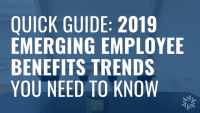
Do you have FSA funds left in your flexible spending account? If your FSA arrangement does not include roll-over or a grace period, you might lose that money at the end of the year. What should you spend the rest of your 2016 FSA funds on? Check out our ideas below and learn more about your flexible spending account.
What you need to know:
What’s your FSA policy on leftover funds?
Some FSA arrangements allow you to roll-over up to $500 into the next plan year or offer a grace period of up to 2.5 months after the end of the year. Check with your Austin Account Director, your HR representative, or your policy documentation to check your options.
What can be purchased with FSA funds?
To spend the rest of your FSA funds for the year, you’ll need a clear understanding of what purchases are eligible. As a general rule, every expense should have a medical need and every medicine should have a prescription.
What are the benefits of an FSA?
According to the Internal Revenue Service, these are the benefits of an FSA (IRS Publication 969):
- Contributions made by your employer can be excluded from your gross income.
- No employment or federal income taxes are deducted from the contributions.
- Withdrawals may be tax-free if you pay for qualified medical expenses.
- You can withdraw funds from the account to pay qualified medical expenses even if you have not yet placed the funds in the account.
How to spend your FSA funds:
Have you paid all outstanding premiums, co-pays, and bills?
Your first stop should be to your records to see if you are up-to-date on all your medical bills. If not, many of these are able to paid with your FSA account. Haven’t seen your doctor, dentist, or optometrist this year? Go now and pay for your visit, glasses, contacts, etc. with the rest of your FSA funds.
Ask your doctor for help getting a prescription for OTC medications
Any medications must have a prescription when using your FSA. Most doctors are willing to work with you to help you get prescriptions for items like vitamins, allergy treatments, pain medication, etc. Stock up on your seasonal medications for the whole family before the end of the year. Even with a prescription, you may still need to submit a reimbursement claim for OTC medicines.
Is your first aid or emergency kit fully stocked?*
Stock up on essentials like bandages, thermometers, ointments, sunscreen, hot/cold packs, etc. Expand your medical equipment by purchasing a stethoscope or blood pressure monitor. Having these items on hand can keep you more involved in your households’ health and provide valuable information for your doctor pre-appointment. Don’t have a first aid kit? Buying a pre-made kit at your local drugstore is most likely covered by your FSA.
*Make sure that either your doctor has written a prescription for these items or signed a medical necessity form to ensure you can be reimbursed or pay for eligible items.
Do you need/get help managing a medical condition?
Classes you attend for help managing issues like diabetes or weight management are an eligible expense. If it is medically necessary, you may even pay for exercise equipment with FSA money.
Do you need therapy to treat a condition?
Therapy treatment is covered by your FSA that includes things from psychotherapy to acupuncture or massage therapy. Check in with your doctor for a prescription and referral.
Did you drive to any appointments this year?
You can claim reimbursement for mileage to your doctor’s appointments. Use Google Maps or MapQuest to enter your start/finish addresses and provide the map along with the resulting mileage to your FSA provider along with receipts associated with that doctor or pharmacy visit.
Plan for Next Year:
Are you tying up too much money in your FSA account?
Even though your FSA money is tax-free, are you missing out on having some extra money for other intentions throughout the year? Check out your medical expenses for the last year to find out if you need to change your contribution going forward. The limit on contributions to an FSA for 2017 is $2,600, up $50 from 2016.
Want even more information about FSAs? Check out our comprehensive FSA presentation below. Still have questions about how to handle your FSA? Contact Austin today!
*Note: FSA contributions have increased to $2,600 for 2017 from $2,550 in 2016.
Sources:
https://www.dailyworth.com/posts/2308-how-to-spend-fsa-money
http://www.getrichslowly.org/blog/2015/11/30/9-different-ways-to-spend-fsa-dollars/


